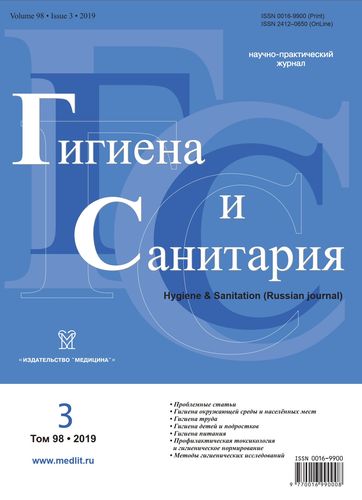Features of the chemical composition of the diet and nutritional status of indigenous and newcomers in the Russian Arctic
- Authors: Baturin A.K.1, Pogozheva A.V.1, Keshabyants E.E.1, Soto S.H.1, Kobelkova I.V.1, Kambarov A.O.1
-
Affiliations:
- Federal Research Center of Nutrition and Biotechnology
- Issue: Vol 98, No 3 (2019)
- Pages: 319-323
- Section: FOOD HYGIENE
- Published: 14.10.2020
- URL: https://rjsocmed.com/0016-9900/article/view/640227
- DOI: https://doi.org/10.47470/0016-9900-2019-98-3-319-323
- ID: 640227
Cite item
Full Text
Abstract
The study of actual nutrition and nutritional status was conducted in 180 residents of the settlements of Tazovsky and Gyda of the Yamal-Nenets Autonomous District. In comparison with the out-of-town population, Arctic indigenous people reliably consume bakery products, meat products (due to venison), fish and fish products, and less - dairy products, vegetables and mushrooms, fruits, berries, dried fruit, vegetable, fruit and fruit juices. When analyzing the chemical composition of the diet, in comparison with the indices of the newborn population, the caloric content of the ration was significantly higher because of its higher protein content (18% of calories). The fat content in the diet of the indigenous population was almost close to the recommended values (30% by caloric content), while in the alien population it exceeded them (33%). The indigenous population, in comparison with the out-of-home population, had a lower content of total and animal fat in the diet, mono- and disaccharides against a background of lower BMI (27.2 kg / m2 and 28.8 kg / m2, respectively) and fat mass. Body factors also were affected by genetic factors. The indigenous population consumed less Vitamin C (2 times) compared to the alien, which was due to the significantly lower content of vegetables, fruits, berries and fruit juices in their diet, and Ca at an unfavorable ratio of Ca: P (1: 2.5) On the background of insufficient intake of dairy products, and more - sodium due to canned (smoked, dried and salted) fish.
Keywords
About the authors
A. K. Baturin
Federal Research Center of Nutrition and Biotechnology
Author for correspondence.
Email: noemail@neicon.ru
Russian Federation
Alla V. Pogozheva
Federal Research Center of Nutrition and Biotechnology
Email: allapogozheva@yandex.ru
MD, prof., leading researcher of the Laboratory of epidemiology, nutrition, and gene diagnostic alimentary-related diseases. Federal Research Centre of Nutrition and Biotechnology, Moscow, 109240, Russian Federation.
E-mail: allapogozheva@yandex.ru
Russian FederationE. E. Keshabyants
Federal Research Center of Nutrition and Biotechnology
Email: noemail@neicon.ru
Russian Federation
S. H. Soto
Federal Research Center of Nutrition and Biotechnology
Email: noemail@neicon.ru
Russian Federation
I. V. Kobelkova
Federal Research Center of Nutrition and Biotechnology
Email: noemail@neicon.ru
Russian Federation
A. O. Kambarov
Federal Research Center of Nutrition and Biotechnology
Email: noemail@neicon.ru
Russian Federation
References
- Aftanas L.I., Voivod M.I., Puzyrev V.P. Arctic Medicine: Challenges of the XXI century. Scientific and technical problems of the Arctic. RAS. Moscow: Nauka. 2014: 117 p. (in Russia)
- Revich B.A., Shaposhnikov D.A. Extreme temperature episodes and mortality in Yakutsk, East Siberia. Rural and Remote Health. 2010; 10: 1-8.
- Young T.K, Makinen T.M. The Health of Arctic Populations: Does Cold Matter? Am. J. Hum. Biol. 2010; 22: 129–33.
- Tchernyak A.Y., Petrov I.M., Sholomov I.F. Metabolic disorders correction in patients with metabolic syndrome and hypertension living in condition of the North. Journal of Hypertention. 2012; 30 (e-Supp. A): 311-2.
- Tokarev S.A., Buganov A.A. Evaluation and prognosis of non-infectious risk in children in dependence on age and period of living in the Far North. Alaska Med. 2007; 49 (2): 142−4.
- Alaska Obesity Facts Report 2014. Alaska, Governor Department of Health and Social Services. Publication Date: May 2014.
- Maksimov SN, Nikitin SG, RG Savin Feeding habits of the population of the Arctic zone. Collected articles interregional scientific-practical conference “Power - the basis of lifestyle and health of the population in the North”, Yakutsk, 4-5 April 2012, p. 110-1. (in Russian)
- Baturin A.K., Sorokinа E.Yu., Pogozheva A.V., Keshabyants E.E., Kobelkova I.V., Kambarov A.O., Elizarova E.V., Tutelyan V.A. The association of rs993609 polymorphisms of gene FTO and rs659366 polymorphisms of gene UCP2 with obesity among Arctic Russian population. Voprosy Pitaniia. 2017; 86 (3): 32-9. (in Russian)
- Baturin A.K., Sorokinа E.Yu., Pogozheva A.V., Tutelian V.A. The association of genetic polymorphisms with non-communicable disease among Arctic population. Voprosy Pitaniia. 2016; 85 (5): 5-12. (in Russian)
- Abramov A.F. Robbek NS Providing daily nutritional needs of indigenous peoples by eating venison. Collected articles interregional scientific-practical conference “Power - the basis of lifestyle and health of the population in the North”, Yakutsk, April 4-5, 2012, р.108-10. (in Russian)
- Martinchik AN, Baturin AK, Baev VS et al. Development of a method of research of the actual power to analyze the frequency of food consumption: the creation of a questionnaire and an overall assessment of the reliability of the method. Voprosy Pitaniia.1998 (3): 8-13. (in Russian)
- Lemas D.J., Klimentidis Y.C. Wiener H.C. et al. Obesity polymorphisms identified in genome-wide association studies interact with n-3 polyunsaturated fatty acid intake and modify the genetic association with adiposity phenotypes in Yup’ik people. Genes Nutr.2013; 8: 495–505.
Supplementary files









